Jakarta Data Center Market Size
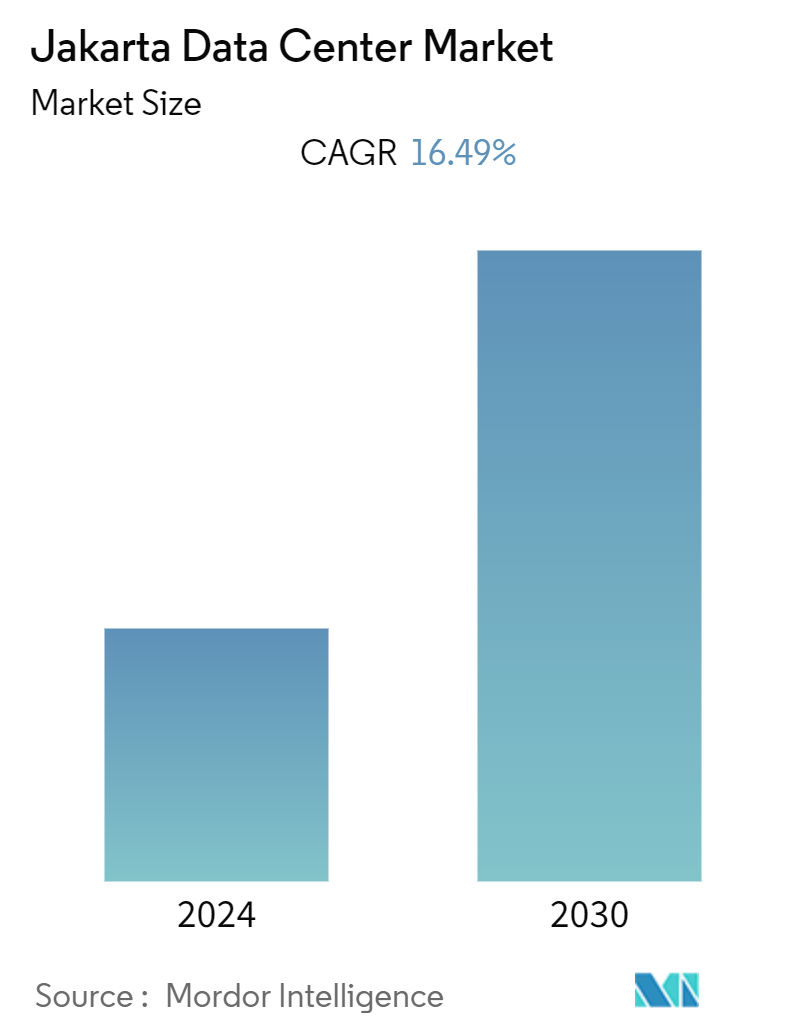
| Study Period | 2019 - 2030 |
| Base Year For Estimation | 2023 |
| Forecast Data Period | 2024 - 2030 |
| Historical Data Period | 2019 - 2022 |
| CAGR (2024 - 2030) | 16.49 % |
| Market Concentration | Medium |
Major Players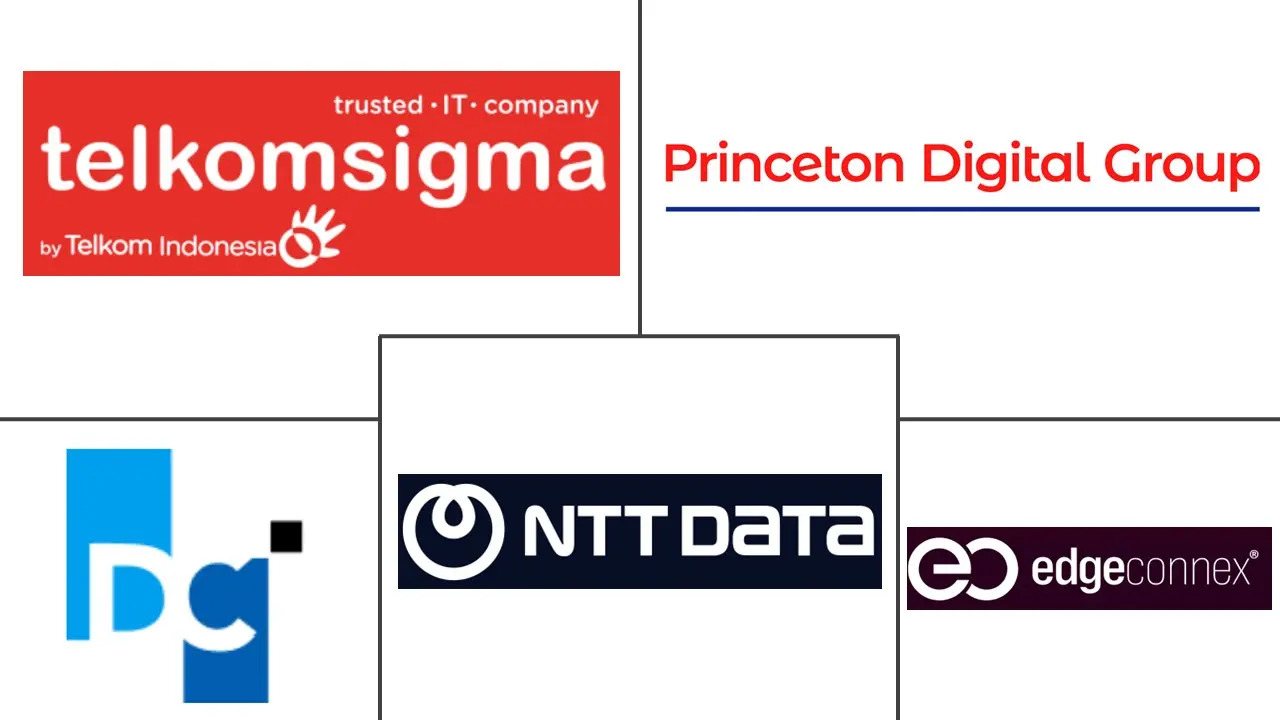
*Disclaimer: Major Players sorted in no particular order |
Jakarta Data Center Market Analysis
The Jakarta Data Center Market is expected to register a CAGR of 16.49% during the forecast period.
The main drivers anticipated to drive the market expansion are the increasing demand for energy-efficient data centers, considerable investment by colocation service and managed service providers, and expanding hyperscale data center building. Additionally, the development of Big Data, cloud computing, and the Internet of Things (IoT) has made it possible for businesses to invest in new data centers to preserve business continuity.
- Additionally, industrial development is expected to prosper due to the rising need for security, operational efficiency, improved mobility, and bandwidth. Software-based data centers boost industry growth by providing a higher level of automation.
- There are various reasons for the growth of data centers in Jakarta. One of the primary reasons is the country's rapidly growing digital economy and the increasing adoption of cloud services and big data analytics by businesses in the region. With a population of over 270 million people and a fast-growing middle class, Jakarta has become an attractive market for international technology companies looking to expand their operations and establish a presence in Southeast Asia.
- Another significant factor driving the growth of data centers in Jakarta is the government's push to develop digital infrastructure and increase connectivity across the country. The government is investing heavily in expanding the country's internet and broadband infrastructure, which is making it easier for people to access online services and for businesses to deploy cloud-based applications and services.
- More than any other application, artificial intelligence (AI) with machine learning (ML) needs the construction of whole new data center architecture. AI and machine learning (ML) may require three times the power density of typical data processing, necessitating a data center architecture revolution. To sustain the higher output, specialized cooling systems are also required. Because of the intensive nature of AI and ML computations, there may be a large dispersion of computational, memory, and storage resources among multiple processors in a computing cluster.
- The government in the city is partnering with various AI service providers to deploy the capabilities of AI; this would push the construction of data centers in the region. For instance, in September 2022, the SAS Institute was strengthening its relationship with the Jakarta City Government by aiding with the city's Flood Control System. The JAKI platform predicts and monitors at-risk locations in real time using SAS Analytics for IoT to mitigate potential damage or harm and raise public awareness of crises.
- With these predictive powers and analysis, the Jakarta City Government can determine when to activate water pumps, accelerating disaster response and improving flood preparedness. The SAS solution uses AI and machine learning to quickly and accurately acquire and act on enormous volumes of data in real time, resulting in a shorter time or speed to take essential actions that limit or eliminate damage to life, property, and enterprises in the city.
- Moreover, development centers have undertaken a substantial study on energy efficiency in data centers, concentrating on optimal quality of service, effective resource utilization, and cost-cutting operations. They intend to reduce brown energy consumption by offering a load-balancing strategy that uses available green energy. Load balancing is based on renewable energy and has been used in several data centers. A workload and energy management plan was implemented to reduce network operational and energy costs. Combined cooling, heating, and power (CCHP) systems can also cut carbon emissions and air pollution while increasing resource energy efficiency dramatically.
Jakarta Data Center Market Trends
Tier 4 is Expected to Hold Significant Share of the Market
- The tier-IV certification is currently the highest classification among data center facilities. These data centers require huge capital compared to other tiered data centers and are usually present in developed economies. Jakarta is still a developing data center market with an internet penetration of about 50%. The low-tiered data centers in Jakarta more feasibly handle the amount of traffic generated. The companies have shown less interest in having facilities with tier IV status in the region.
- Major companies like Microsoft and Amazon, which operate massive data centers in other regions, have restricted their operations to lower-tiered data centers in Jakarta. Companies like NTT and DCI have shown interest in having tier IV facilities in the future. Still, significant investments and expansions have been more toward tier II and III data centers. Moreover, tier-IV providers have redundancies (2N+1) for every process and the data protection stream. No single outage or error can shut down the system and provide 99.9% uptime annually, the highest guaranteed uptime. The level IV infrastructure should have at least 96 hours of independent power to qualify in this tier. This power should not be connected to any outside source and should be entirely proprietary.
- This tier also ensures optimized efficiency. The servers are housed in the most physically advantageous locations. This drastically extends the life of the hardware. If temperature and humidity are kept consistent, one can gain great efficiency. Even the backups and dual power sources are treated like primaries. Also, the tier-IV data center can require up to 3 to 1 of the space required to facilitate the IT footprint. For tier IV, the kW cost component is USD 25,000/kW of the redundant UPS capacity for IT.
- Tier-IV is considered an enterprise-level service. Companies without international reach and consistently high web traffic do not usually require tier-IV facilities. Tier IV has As technological advancements, such as AI, IoT, and 5G, are leading the digital transformation, various industry sectors, such as government, finance, media, and manufacturing, are starting to demand advanced data centers with high reliability. By leveraging their years of expertise, only some prominent technological vendors in the region are launching services allowing end-users to manage data center operations better.
- For instance, PT DCI Indonesia (DCI) formally launched its fourth data center facility, JK5, in Cibitung, West Java, to support the cities' digital economy's long-term expansion, estimated to reach USD 130 billion by 2025. DCI is Southeast Asia's first tier-IV data center, providing dependable, integrated, well-managed cloud and carrier-neutral infrastructure services to many local and international customers. Its state-of-the-art campus in Cibitung, Bekasi, is only 40 kilometers from Jakarta's Central Business District.
- According to GSMA Intelligence, there were 370.1 million cellular mobile connections in Indonesia by the beginning of 2022. Mobile connections in Indonesia were comparable to 133.3% of the total population in January 2022. Between 2021 and 2022, the number of mobile connections in Indonesia increased by 13 million (+3.6 percent). Such a huge number of mobile users would drive the demand for the studied market.
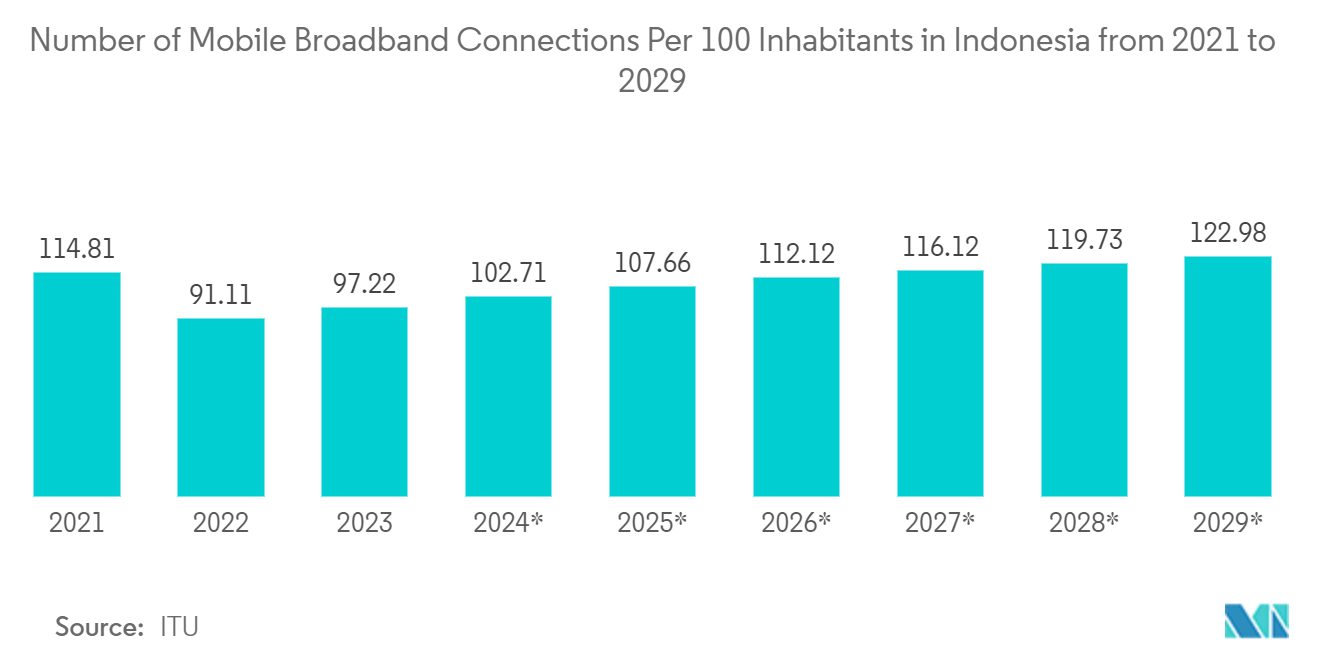
BFSI is Expected to Drive the Market
- In the last three years, major local and international data center players have gradually entered the Jakarta Indonesian market, drawn by the country's socio-economic potential. Indonesia has the world's fourth-largest population and is the largest in Southeast Asia. A large proportion of tech-savvy youth and favorable demographics aid the growth of data centers across the country. According to Jones Lang LaSalle IP Inc., currently, approximately 73% of 270 million people in the country use the internet daily, making the country one of the largest online markets in the world. As a result, many digital services, such as e-commerce and financial, are emerging.
- Jakarta banking, financial services, and insurance sectors are rapidly changing. Banks and insurance companies must reinvent themselves due to the changing regulations, emerging technology, elevated client expectations, and the entry of disruptive competitors. The city is one of the most valuable untapped markets in APAC's digital finance sector. More than 50% of the country's population is currently unbanked, presenting an incredible opportunity for banks and fintech to adopt the technology and offer services, as the adoption of smart devices by the people is expected to grow day by day. The country offers a strong potential for market growth, owing to its vast young population and relatively low smartphone penetration. These factors are expected to drive the studied market in the forecast period.
- Similarly, in the fintech industry, online lending has been boosting the demand in the region. Thus, online banking is expected to become more popular in jakartawith each passing year, and it is expected to increase the demand for resilient, safe, cost-effective, and energy-efficient data center solutions. The majority of the banks in jakarta offer online banking services. Thus, for the financial service providers in the country, data center solutions are becoming a popular choice to extend the capacities of the existing data centers as they emerge as a backup setup for disaster management.
- Additionally, enabled by the increased adoption of mobile technology, the future of digital payments across the region looks optimistic, with the number of digital payment methods expected to rise in the near term. For instance, in January 2022, Bank Indonesia (BI), the country's central bank, developed BI-FAST, the country's first real-time payment infrastructure, with the help of ACI Worldwide, a developer of real-time digital payment software.
- BI-FAST is an essential component of Indonesia's continuing digital transformation project and a key component of its payment system blueprint, IPS 2025. IPS 2025 intends to improve the country's payment infrastructure, integrate the country's digital economy and finance sector, and answer the public demand for a rapid, easy, safe, economical, and dependable payment system. Such developments in the banking sector will increase the demand for data centers in the region.
- According to Financial Services Authority (Indonesia), as of January 2022, 107 different commercial banks were located in Indonesia. A huge number of banks in the region would create an opportunity for the rise in online transactions and a lot of data regarding KYC, and this would push the various banks in the region to adopt the services to the data center and allow the international firms to establish new data centers in the city.
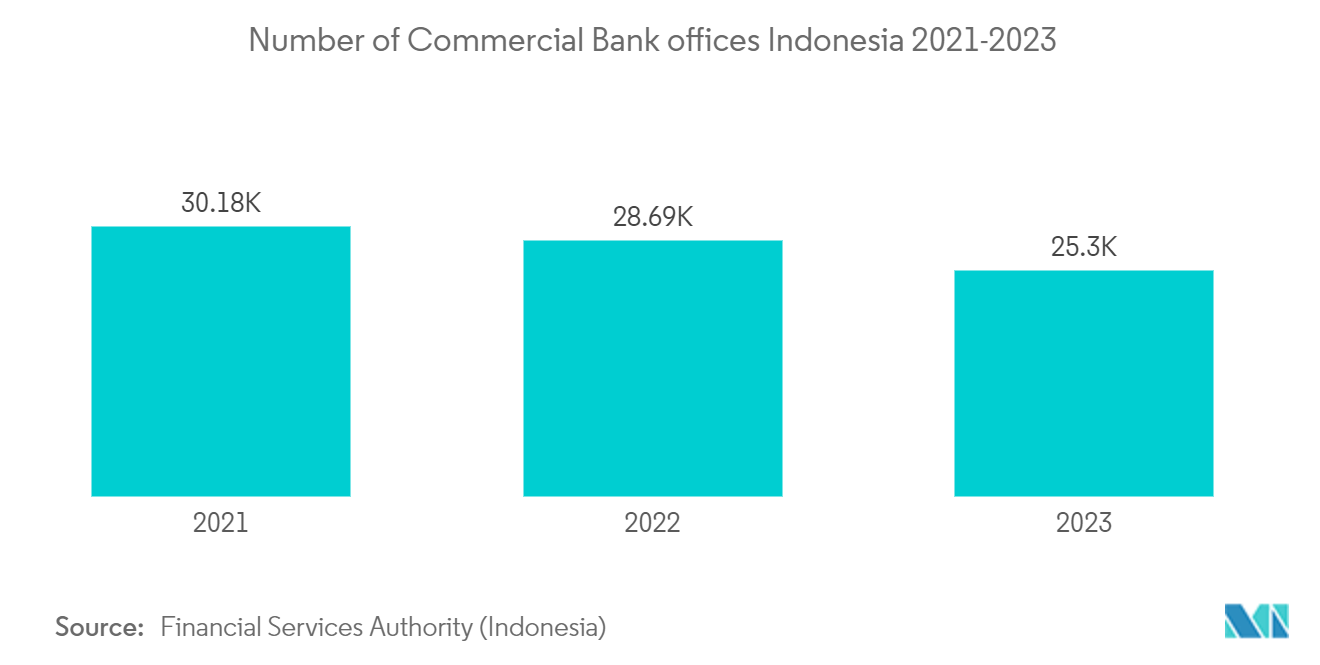
Jakarta Data Center Industry Overview
The Jakarta Data Center market is moderately consolidated with the presence of several players like PT DCI Indonesia, Telkomsigma, NTT Communications Corporation, XL Axiata Tbk PT (Princeton Digital Group) etc. The companies continuously invest in strategic partnerships and product developments to gain substantial market share.
In October 2022, the digital infrastructure player Equinix Inc. announced its expansion into Indonesia with plans for an approximately USD 74 million International Business Exchange data center in Jakarta to meet the rising demand for the digital services necessary to power today's enterprises. Through this expansion, Equinix will make it possible for Indonesian companies and foreign companies with a presence in Indonesia to use its dependable platform to link and connect the basic infrastructure that underpins their companies.
In October 2022, K2 Data Centres and SinarMas Land (SML) formed a joint venture to own, develop, and run hyperscale data centers in Jakarta, Indonesia. When fully built out, the JV's first project, K2 Data Centre Jakarta 1 Campus (K2 JKT 1), will have four data center facilities in Bekasi Regency, Greater Jakarta, and provide 58.8MW of IT capacity. The K2 JKT 1 Campus' initial phase will be operational in early 2024, according to the company's current construction efforts. According to the business, the building will be LEED Gold certified and Uptime Institute Tier III accredited.
Jakarta Data Center Market Leaders
-
PT DCI Indonesia
-
Telkomsigma
-
NTT Communications Corporation
-
XL Axiata Tbk PT (Princeton Digital Group)
-
GTN Data Center (Edge Connex)
*Disclaimer: Major Players sorted in no particular order
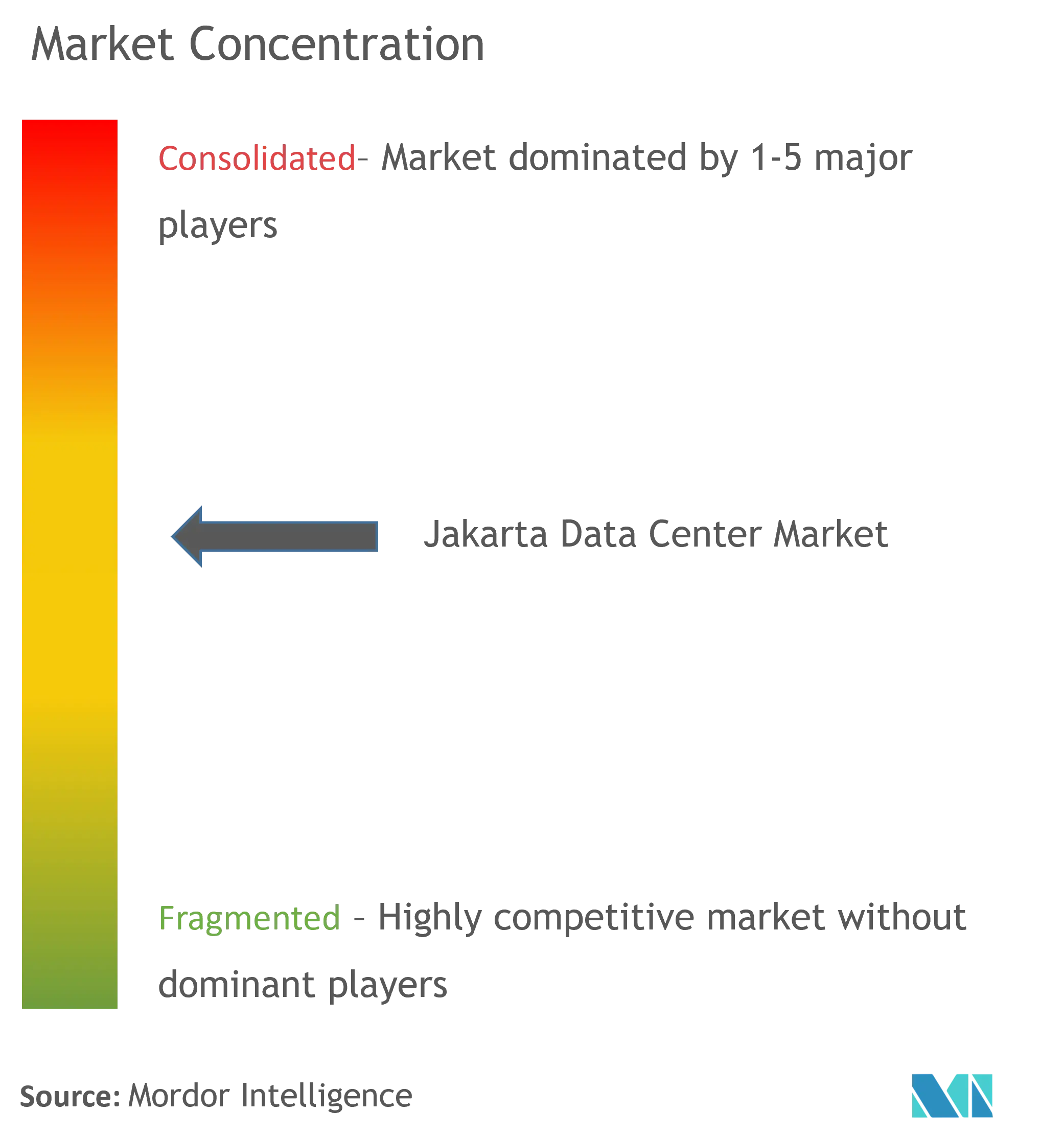
Jakarta Data Center Market News
- Apr 2023: BDxIndonesia, a BDxaffiliate, began constructing a new greenfield data center, CGK3A, in TB Simatupang, South Jakarta. The data center, which has a capacity of 15 MW, seeks to deliver top data center services to Indonesian businesses and hyperscalers. The new 14,127-square-meter data center is outfitted with Tier 3 data center facilities, advanced security systems, automation technology, and high network uptime, as well as a below-average power usage effectiveness (PUE) of 1.4, which provides operational excellence and a sustainable solution without sacrificing productivity and scalability.
- Dec 2022: ST Telemedia Global Data Centres (Indonesia), a data center provider, announced the structural completion of STT Jakarta 1, its first data center facility in Indonesia. The new facility is the first building on the data center campus, which was created through a collaboration between leading Indonesian conglomerate TriputraGroup and global investment firm Temasek. When fully operational in Q2 2023, the data center campus will support up to 72 megawatts of essential IT capacity, with STT Jakarta 1 supporting up to 19.5 megawatts.
Jakarta Data Center Market Report - Table of Contents
1. INTRODUCTION
- 1.1 Study Assumptions and Market Definition
- 1.2 Scope of the Study
2. RESEARCH METHODOLOGY
3. EXECUTIVE SUMMARY
4. KEY INDUSTRY TRENDS
- 4.1 Smartphone Users
- 4.2 Data Traffic per Smartphone
- 4.3 Mobile Data Speed
- 4.4 Broadband Data Speed
- 4.5 Regulatory Framework
- 4.6 Value Chain Analysis
5. MARKET OUTLOOK
- 5.1 IT Load Capacity
- 5.2 Raised Floor Space
- 5.3 Number of Racks
6. MARKET SEGMENTATION
-
6.1 DC Size
- 6.1.1 Small
- 6.1.2 Medium
- 6.1.3 Large
- 6.1.4 Massive
- 6.1.5 Mega
-
6.2 Tier Type
- 6.2.1 Tier 1 & 2
- 6.2.2 Tier 3
- 6.2.3 Tier 4
-
6.3 Absorption
- 6.3.1 Utilized
- 6.3.1.1 Colocation Type
- 6.3.1.1.1 Retail
- 6.3.1.1.2 Wholesale
- 6.3.1.1.3 Hyperscale
- 6.3.1.2 End User
- 6.3.1.2.1 Cloud & IT
- 6.3.1.2.2 Telecom
- 6.3.1.2.3 Media & Entertainment
- 6.3.1.2.4 Government
- 6.3.1.2.5 BFSI
- 6.3.1.2.6 Manufacturing
- 6.3.1.2.7 E-Commerce
- 6.3.1.2.8 Other End User
- 6.3.2 Non-Utilized
7. COMPETITVE LANDSCAPE
-
7.1 Company Profiles*
- 7.1.1 PT DCI Indonesia Tbk
- 7.1.2 PT Sigma Cipta Caraka (Telkomsigma)
- 7.1.3 NTT Ltd.
- 7.1.4 PT XL Axiata Tbk (Princeton Digital Group)
- 7.1.5 EdgeConneX Inc. (GTN Data Centers)
- 7.1.6 NEX Data Center Indonesia
- 7.1.7 PT Indosat Tbk (Big Data Exchange (BDx))
- 7.1.8 PT DWI Tunggal Putra (DTPNet)
- 7.1.9 PT Jupiter Jala Arta (JupiterDC)
- 7.1.10 Biznet Data Center
- 7.1.11 Nusantara Data Center
- 7.1.12 Space DC Pte Ltd
- 7.1.13 Digital Edge DC
- 7.2 Market share analysis (In terms of MW)
- 7.3 List of Companies
Jakarta Data Center Industry Segmentation
A data center is a physical room, building, or facility that holds IT infrastructure used to construct, run, and provide applications and services and store and manage the data connected with those applications and services.
The Jakarta data center market is segmented by dc size (small, medium, large, massive, and mega), tier type (tier 1 and 2, tier 3, and tier 4), and absorption (utilized (colocation type (retail, wholescale, and hyperscale), end user (cloud and IT, telecom, media and entertainment, government, BFSI, manufacturing, and e-commerce)), and non-utilized). The market sizes and forecasts are provided in terms of volume (MW) for all the above segments.
| DC Size | Small | ||
| Medium | |||
| Large | |||
| Massive | |||
| Mega | |||
| Tier Type | Tier 1 & 2 | ||
| Tier 3 | |||
| Tier 4 | |||
| Absorption | Utilized | Colocation Type | Retail |
| Wholesale | |||
| Hyperscale | |||
| Absorption | Utilized | End User | Cloud & IT |
| Telecom | |||
| Media & Entertainment | |||
| Government | |||
| BFSI | |||
| Manufacturing | |||
| E-Commerce | |||
| Other End User | |||
| Absorption | Non-Utilized |
Jakarta Data Center Market Research Faqs
What is the current Jakarta Data Center Market size?
The Jakarta Data Center Market is projected to register a CAGR of 16.49% during the forecast period (2024-2030)
Who are the key players in Jakarta Data Center Market?
PT DCI Indonesia, Telkomsigma, NTT Communications Corporation, XL Axiata Tbk PT (Princeton Digital Group) and GTN Data Center (Edge Connex) are the major companies operating in the Jakarta Data Center Market.
What years does this Jakarta Data Center Market cover?
The report covers the Jakarta Data Center Market historical market size for years: 2019, 2020, 2021, 2022 and 2023. The report also forecasts the Jakarta Data Center Market size for years: 2024, 2025, 2026, 2027, 2028, 2029 and 2030.
Jakarta Data Center Industry Report
Statistics for the 2024 Jakarta Data Center market share, size and revenue growth rate, created by Mordor Intelligence™ Industry Reports. Jakarta Data Center analysis includes a market forecast outlook to for 2024 to 2030 and historical overview. Get a sample of this industry analysis as a free report PDF download.



